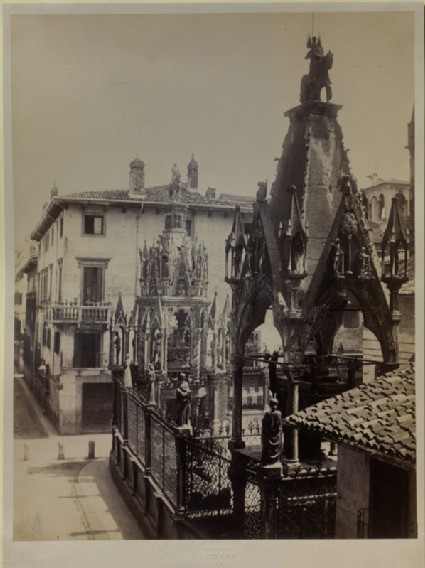Browse: 1470 objects
Photograph of the Tombs of Mastino II della Scala and Cansignorio della Scala, Verona Maurizio Lotze
-
Details
- Artist/maker
-
Maurizio Lotze (1809 - 1890) (photographer)after Bonino da Campione, II, II (active c. 1349 - d. 1392 or 1393) (sculptor)
- Object type
- photograph
- Material and technique
- albumen print
- Dimensions
- 314 x 241 mm (print); 337 x 252 mm (mount)
- Associated place
-
- Europe › Italy › Veneto (Venetia) › Verona › Verona › Chiesa di Santa Maria Antica › Tomb of Mastino II della Scala › Tomb of Mastino II della Scala (subject)
- Europe › Italy › Veneto (Venetia) › Verona › Verona › Chiesa di Santa Maria Antica › Tomb of Cansignorio della Scala › Tomb of Cansignorio della Scala (subject)
- Inscription
- On the front of the mount, bottom centre, blind stamped: FOTOGRAFIA | MAURIZIO LOTZE | VERONA
On the back of the mount, all in graphite:
top, left of centre: R/96
just to the right, struck through: 96
just above centre: R. 96
centre, towards bottom, the Ruskin School's stamp
- Provenance
-
Presented by John Ruskin to the Ruskin Drawing School (University of Oxford), 1875; transferred from the Ruskin Drawing School to the Ashmolean Museum, c.1949.
- No. of items
- 1
- Accession no.
- WA.RS.RUD.096
-
Subject terms allocated by curators:
Subjects
-
References in which this object is cited include:
References
Ruskin, John, The Ruskin Art Collection at Oxford: Catalogue of the Rudimentary Series, in the Arrangement of 1873, ed. Robert Hewison (London: Lion and Unicorn Press, 1984), cat. Rudimentary no. 96, RUD.096
Ruskin, John, Instructions in Practice of Elementary Drawing, Arranged with Reference to the First Series of Examples in the Drawings Schools of the University of Oxford (n.p., [1872]), cat. Rudimentary no. 96
Ruskin, John, Instructions in the Preliminary Exercises Arranged for the Lower Drawing-School (London: Smith, Elder, 1872), cat. Rudimentary no. 96
Ruskin, John, Instructions in the Preliminary Exercise Arranged For the Lower Drawing-School (London: Spottiswoode, 1873), cat. Rudimentary no. 96
Ruskin, John, ‘Rudimentary Series 1878’, 1878, Oxford, Oxford University Archives, cat. Rudimentary no. 96
Ruskin, John, ‘The Ruskin Art Collection at Oxford: Catalogues, Notes and Instructions’, Edward T. Cook and Alexander Wedderburn, eds, The Works of John Ruskin: Library Edition, 39 (London: George Allen, 1903-1912), 21, cat. Rudimentary no. 96
Location
-
- Western Art Print Room
Position in Ruskin’s Collection
Ruskin's Catalogues
-
Ruskin's Rudimentary series, 3rd ed. (1872)
R|96} Tombs of Can Mastino and Can Signorio, seen together. P. -
Ruskin's Rudimentary series 4th ed. (1872)
R|96} Tombs of Can Mastino and Can Signorio, seen together. P. -
Ruskin's Rudimentary series, 5th ed. (1873)
R|96} Tombs of Can Mastino and Can Signorio, seen together. P. -
Ruskin's revision to the Rudimentary series (1878)
remains 95.Sketch showing the general colour of the above monument. Its red marble is slightly blanched by time and its white marble yellowed and more or less patched with black lichen - the general plan of it being, the roof of common grey limestone, the crockets, more or less worn away, of white marble, the cornice supporting the equestrian figure in red marble, as also the lateral niches, and the gable and cusps of the arch, while the two figures of Abel & Cain, the tree between them, the shield above and the panel-sculptures round the R. pointed arch are in pure white marble. I am ashamed of myself for ever having done sketches so thin & poor in tone as this, but it must be remembered that they profess to be nothing more than pencil memoranda washed with colour merely for information and not as a colour-drawing. To have painted the gable properly would have taken me at least a fortnight, and a fortnight was all I had to look at and form judgement of the architecture of all the town. Such as it is, every touch of the drawing is bestowed with care and, with the help of the photograph, will sufficiently explain the character of the monument.






